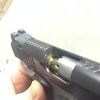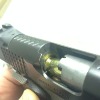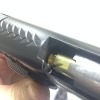I ordered this flat wire spring kit (which I will try first) and a wilson HD extractor for good measure. Looks like 1911Tuner is MIA but if anyone else could help me with filing/adjusting the Wilson HD extractor I'd appreciate it.
Let's start at the back of the extractor. The firing pin stop should fit into the groove at the back of the extractor snugly. It doesn't have to be so tight as to require tools to install or remove but it should prevent the extractor from rotating or moving fore and aft. If your firing pin stop allows this movement, replace it with an
EGW oversized firing pin stop. It will have to be filed or sanded to fit correctly.
Once that is done you can look at the extractor deflection fitting pad. The easiest way to set deflection is to make yourself a simple flat metal guage of a specific width that will slide up between the extractor and the left guide block. Think of it as a fat feeler guage. I set the width of my homemade gauge to .466" and it works fine. You can buy flat pieces of aluminums stock from home depot which will be much faster and easier to file than steel. You will need a set of calipers to do accurate measurements.
The concept is to install the extractor then slip your homemade guage in. If the extractor tensioning wall doesn't touch the guage, remove material from the extractor fitting pad until it does contact the guage. Now that the deflection is set you can gently break the the bottom edge of the tensioning wall and round the bottom of the claw slightly.
Finally, slide a round under the extractor. The base of the case should be able to be pushed back flush against the breechface. If it will not, look carefully at the claw. The edge of the claw should just barely clear the bottom of the case extractor groove. Also, the forward face of the claw should not be in contact with the case bevel. If it is touching the case bevel, you need to carefully file it until it until it clears the bevel.
Now you can worry about tension. Bend the extractor a little and install it. Slip a loaded round in place and shake the slide a bit. The round should stay in place. If you shake the slide vigorously, the loaded round should drop free.
Go shoot the pistol. If you experience any failures-to-feed where the cartridge is not quiite all way in the chamber but with a push on the rear of the slide the cartridge will go all the way in, you'll probably want to unbend the etractor just a little to reduce the amount of tension.
Step at a time. Fit the firing pin stop. Set the deflection. Closely inspect the relationship of the claw to a case and tweak as necessary. Add some tension. Go shoot. Go slowly and remember it's much easier to remove metal than put it back on.





